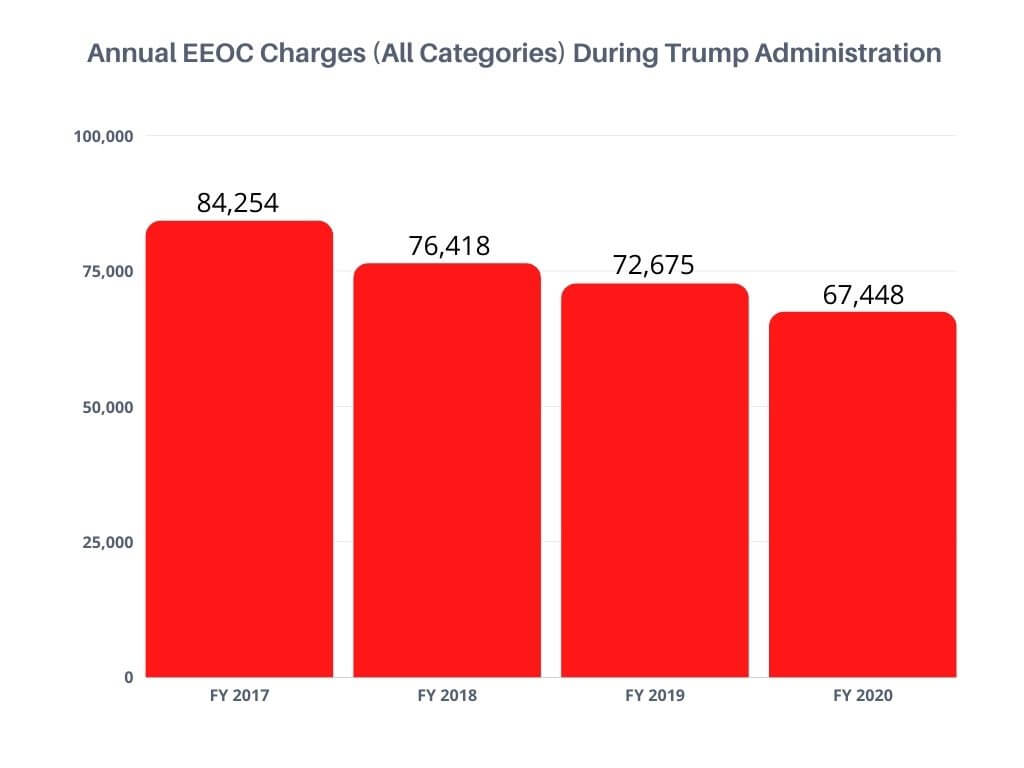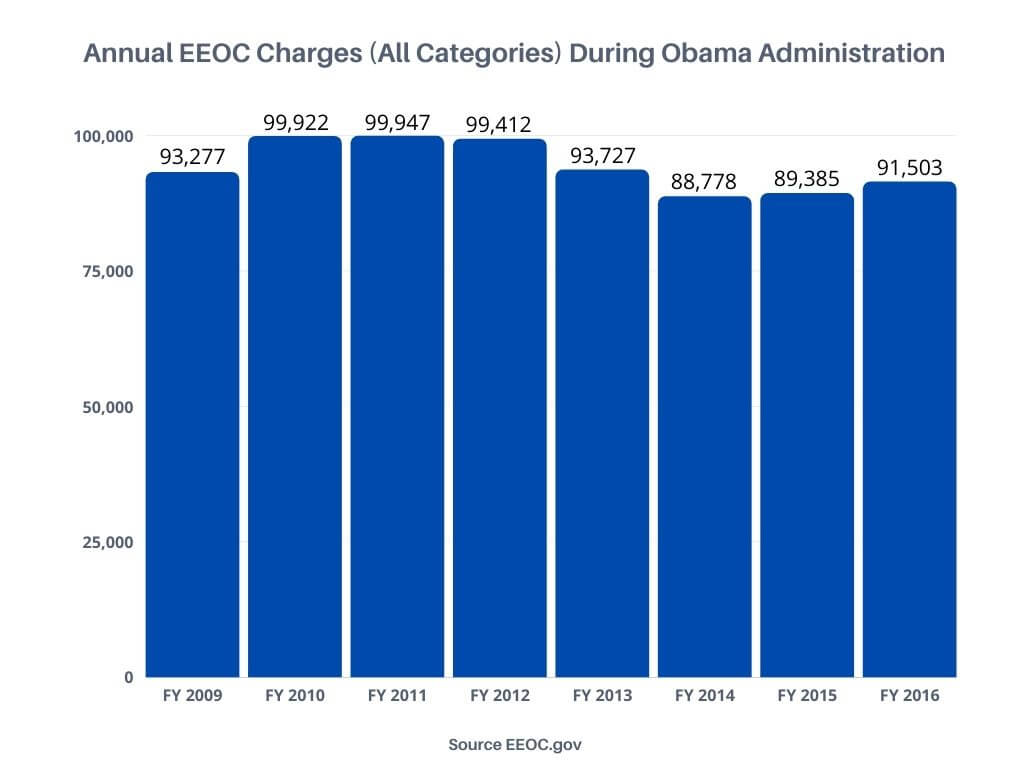Employees filed fewer discrimination claims with the U.S. Equal Employment Opportunity Commission in fiscal year 2020 than any year since at least 1992. The COVID-19 pandemic might have contributed, but the 2020 EEOC charges continued an annual decline seen throughout Donald Trump’s presidency. Should we expect more charges with President Biden in the White House?
FY 2020 EEOC Charges
The latest annual data refer to the 12-month fiscal year ending September 30, 2020. The EEOC received 67,448 charges of employment discrimination during this period. The charges span several federal laws, including Title VII of the Civil Rights Act of 1964, the Age Discrimination in Employment Act (ADEA), the Americans with Disabilities Act (ADA), the Equal Pay Act, and the Genetic Information Non-Discrimination Act (GINA).
More than half (55.8%) of the charges included a retaliation claim, often in addition to claims based on other protected characteristics.
Here is the percentage of total charges that asserted discrimination based on those other characteristics:
- Disability – 36.1%
- Race – 32.7%
- Sex – 31.7%
- Age – 21%
- National Origin – 9.5%
- Color – 5.3%
- Religion – 3.6%
- Equal Pay – 1.5%
- Genetic Information – 0.7%
Totals exceed 100%, as charges can allege more than one category.
Harassment charges, which can be based on any protected characteristic, also continued to fall in FY 2020. Of the total EEOC charges filed last year, 24,221 (35.9%) included a harassment claim.
Sexual Harassment Charges in 2020
Claims of sex-based harassment fell to 11,497, down 11.9% from the FY 2018 peak sparked by the #MeToo movement. That number includes all charges alleging harassment based related to one’s sex (treating people of one sex less favorably than others). The EEOC separately tracks harassment of a sexual nature.
Charges alleging harassment of a sexual nature also fell to the lowest level in many years. The EEOC received 6,587 such charges in FY 2020, down 13.4% from 2018, and 17.1% from 2010.
Trends Since 2016
FY 2016 ended September 30th of that year. Donald Trump was elected in November 2016, and became President on January 20, 2017.
Total EEOC charges fell each year of the Trump Administration, after fluctuating but staying relatively flat during President Obama’s two terms.


What’s Going On?
One reasonable conclusion from the data is that the EEOC was less receptive to employee complaints under President Trump. Note that we are looking at charges that employees brought to the EEOC. What the EEOC did with them after that does not show up in these statistics. So, could the EEOC itself be a factor?
There are likely many ways that the EEOC could affect charge filings. The agency can alter the level of outreach it performs. Potentially, its case handling practices could deter employees from bothering to bring a case forward. It is plausible that both of these occurred during the Trump Administration. However, there could be other causes.
More State Filings?
Another arguably related rationale may be that some employees chose to file their employment discrimination claims with state agencies rather than the EEOC. The EEOC does not fully report state filing data, some of which it likely doesn’t have. However, it does report sexual harassment cases filed in each state, including with state agencies. In total, those cases rose measurably in 2018 and 2019 before dropping back to nearly the 2017 level in 2020. Such cases also dropped gradually over Obama’s eight years as President. This data doesn’t clarify whether employees have shifted their filing preferences from the EEOC to state agencies. But they do suggest that such a shift, if it exists, doesn’t fully explain a reduction in EEOC charges. Nationwide, employees are likely filing fewer discrimination claims overall.
Improved Workplace Culture?
Perhaps incidents of employment discrimination are declining? Maybe. Hopefully. A better way of putting this would probably be that fewer employees feel it is worth it to file discrimination claims. Not every employment discrimination claim has merit, of course. And many employees who suffer discrimination never report it, much less file a formal complaint with a government agency.
Political or Economic Influence?
One way to analyze the difference between the Obama and Trump administrations is to look back at previous presidencies. Maybe the party in control is a variable in EEOC filing statistics.
Bush
Between fiscal years 2001 and 2017, under President George W. Bush (R), the EEOC received an average of 80,000 charges each year. The numbers nearly reached as low as 75,000 in 2005 and 2006, before increasing to 82,792 charges in FY 2007. Then, in 2008, employees filed 95,402 EEOC charges. That comparatively high number was likely related to extreme financial distress as a result of the Great Recession. When more employees lose their jobs and have no alternative source of income, discrimination claims are apt to rise. Those same factors may have contributed to higher numbers of charges during Obama’s first term.
Clinton
Democrat Bill Clinton became President in January 1993. Total EEOC charges increased from 72,302 to 87,942 between FY 1992 and FY 1993. That’s a 21.6% uptick, the largest one-year increase in at least the past 30 years. However, it’s almost entirely accounted for by the implementation of the ADA, which the EEOC began enforcing on July 26, 1992. Disability discrimination claims accounted for 15,274 charges in FY 1993, compared to only 1,048 the previous year. After peaking at 91,189 charges in 1994, there were less than 80,000 charges filed per year over the last five years of the Clinton Administration–slightly below Bush-era levels.
Digging Into the 2020 EEOC Charge Statistics
That history doesn’t seem to explain fully why EEOC charges dropped throughout the Trump presidency. But what else can we find out from the data on 2020 EEOC charges?
All statistics used for this article are available here.
Race/Color Discrimination
The EEOC reports 22,064 charges alleging race discrimination in FY 2020. That’s easily the fewest such claims in the history of the EEOC dataset going back to 1992, representing a 38.5% drop since the peak a decade earlier in FY 2010. Both in absolute numbers and as a percentage of total EEOC charges, race discrimination claims were lower in each of the past three years than at any point over the past three decades.
However, charges based on color discrimination have increased. In FY 2020, 5.3% of charges (3,562) included a claim of color discrimination–the highest level ever for such claims on both a percentage and absolute basis. The reasonable assumption is that more employees are raising color discrimination claims instead of race discrimination. Yet, employees can claim discrimination based on both race and color. So, the increase in color discrimination claims doesn’t necessarily explain the reduction in race discrimination claims.
National Origin Discrimination
Charges alleging national origin discrimination also dropped precipitously under the Trump Administration, from 9,840 in FY 2016 to 6,377 in FY 2020–a 35.2% decline. However, this trend began earlier. National original discrimination charges also dropped 7.5% during Obama’s second term after reaching their historical high-water mark during his first four years.
Other Categories
Charges alleging discrimination based on sex, religion, age, and disability all declined in FY 2020 (as in 2017-2019). But the declines were roughly proportionate to the overall case volume.
It may be of some note that charges alleging GINA violations (genetic information discrimination) more than doubled in 2020 to an all-time high. Yet, they still only accounted for less than 1% of all cases.
Looking Ahead
There are several reasons to believe that employment discrimination charges will go up as soon as 2021.
First, people who lost their jobs due to the coronavirus pandemic still have time to file. In many states, employees have up to 300 days to file an EEOC charge, or maybe longer to file with a similar state agency. The longer people remain out of work, the more incentive they have to assert a claim against a former employer. Plus, COVID-19 probably created logistical issues delaying some filings, which will now appear in the 2021 statistics.
Second, the Biden Administration likely will focus more on protecting employees than its predecessors. Efforts will probably include both extended outreach and more aggressive prosecution of employers. If employees feel like they will have a receptive agency, they should be more prone to file charges.
Third, COVID-19 has changed the workplace in ways that ultimately won’t solve employment discrimination. Harassment and other forms of discrimination could have occurred less often over the past year because people were not physically in workplaces. But discrimination can also occur by remote means, and employees may gradually become more aware of their rights relative to the new work environment. Plus, many people will return to work on-site, where traditional acts of harassment will probably, unfortunately, still be perpetrated.
As ever, employers should be proactive in preventing employment discrimination. Anti-harassment training is one viable approach. Effective hiring practices, training, and supervision are also critical.

You must be logged in to post a comment.